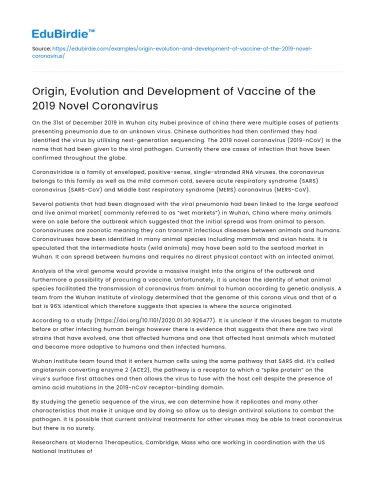On the 31st of December 2019 in Wuhan city Hubei province of china there were multiple cases of patients presenting pneumonia due to an unknown virus. Chinese authorities had then confirmed they had identified the virus by utilising next-generation sequencing. The 2019 novel coronavirus (2019-nCoV) is the name that had been given to the viral pathogen. Currently there are cases of infection that have been confirmed throughout the globe.
Coronaviridae is a family of enveloped, positive-sense, single-stranded RNA viruses. the coronavirus belongs to this family as well as the mild common cold, severe acute respiratory syndrome (SARS) coronavirus (SARS-CoV) and Middle East respiratory syndrome (MERS) coronavirus (MERS-CoV).
Several patients that had been diagnosed with the viral pneumonia had been linked to the large seafood and live animal market( commonly referred to as “wet markets”) in Wuhan, China where many animals were on sale before the outbreak which suggested that the initial spread was from animal to person. Coronaviruses are zoonotic meaning they can transmit infectious diseases between animals and humans. Coronaviruses have been identified in many animal species including mammals and avian hosts. It is speculated that the intermediate hosts (wild animals) may have been sold to the seafood market in Wuhan. It can spread between humans and requires no direct physical contact with an infected animal.
Analysis of the viral genome would provide a massive insight into the origins of the outbreak and furthermore a possibility of procuring a vaccine. Unfortunately, it is unclear the identity of what animal species facilitated the transmission of coronavirus from animal to human according to genetic analysis. A team from the Wuhan Institute of virology determined that the genome of this corona virus and that of a bat is 96% identical which therefore suggests that species is where the source originated.
According to a study (https://doi.org/10.1101/2020.01.30.926477). It is unclear if the viruses began to mutate before or after infecting human beings however there is evidence that suggests that there are two viral strains that have evolved, one that affected humans and one that affected host animals which mutated and became more adaptive to humans and then infected humans.
Wuhan Institute team found that it enters human cells using the same pathway that SARS did. It’s called angiotensin converting enzyme 2 (ACE2), the pathway is a receptor to which a “spike protein” on the virus’s surface first attaches and then allows the virus to fuse with the host cell despite the presence of amino acid mutations in the 2019-nCoV receptor-binding domain.
By studying the genetic sequence of the virus, we can determine how it replicates and many other characteristics that make it unique and by doing so allow us to design antiviral solutions to combat the pathogen. It is possible that current antiviral treatments for other viruses may be able to treat coronavirus but there is no surety.
Researchers at Moderna Therapeutics, Cambridge, Mass who are working in coordination with the US National Institutes of Health, have developed a potential shortcut to decrease the time it takes to create vaccines against ongoing outbreaks such as coronavirus. They are essentially prepping the human body to recognize disease-causing microbes and to activate the human immune system. Researchers at Moderna initiated this process by packing their vaccine with mRNA, Moderna’s idea is to load its coronavirus vaccine with mRNA that codes for the right coronavirus proteins and then inject that into the body. The immune cells can then start manufacturing the right protein for other immune cells to recognize and therefore commence a response against the infection.
The initial step of the development of this vaccine is determining which proteins made by the 2019-nCoV virus should be included in the vaccine. Chinese scientists had publicly posted the genome sequence and Moderna scientists chose specific proteins and thereafter began writing the genetic ‘software’ for their vaccine — in the form of the mRNA specifications that the human body’s cells would need to construct the coronavirus protein.
The developmental process is ongoing, and the team will have to ensure that the final mRNA is reliable and stable then only can it be used in the manufacturing of vaccines which will undergo several clinical trails before being readily available






 Stuck on your essay?
Stuck on your essay?

